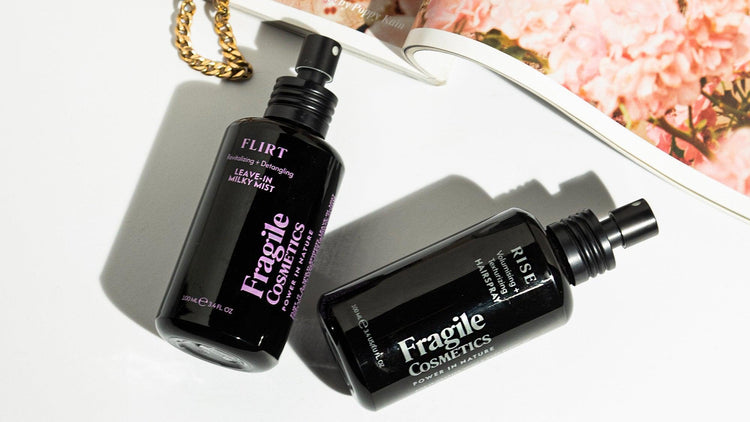Pure vitamin C
This is the best-known and most effective form of vitamin C! You'll find it on the ingredient list of your skincare products under its scientific name: L-ascorbic acid . It offers antioxidant activity at concentrations as low as 0.5% in cosmetics, but some products can contain up to 20% or even 30% – although this concentration is not regulated.
However, it has one major drawback: pure vitamin C is unstable and tends to become inactive as soon as it comes into contact with water. This is why it can only be used in water-based formulas with an acidic pH (below 3.5). This acidity can cause problems for even the most sensitive skin: redness, irritation, tingling… even after a gradual acclimatization period.
The acidity of the formula is also crucial for ensuring vitamin C penetrates the upper layers of your epidermis. Without an acidic formula, it will remain on the surface of your skin barrier – which is hydrophobic by nature, while L-ascorbic acid is hydrophilic. But don't worry: there are other ways to incorporate vitamin C into your routine!
Vitamin C derivatives
Why choose them?
Vitamin C derivatives offer an excellent compromise for formulators and for us skincare enthusiasts. Easier to stabilize in formulas, most are also gentler and therefore compatible with all skin types. This doesn't prevent them from retaining benefits very similar to those of L-ascorbic acid – sometimes with even greater absorption.
Predominantly found in skincare products, these derivative forms are most often ascorbic acid esters. Many exist, each with its own cosmetic and formulation advantages. Some forms, for example, are oil-soluble, while others only mix with water. In all cases, they are ideal for a gentle introduction to vitamin C.
Vitamin C derivatives present in our skincare products
Ascorbyl glucoside : This is a stable form of vitamin C combined with glucose which, once absorbed by the tissues, gradually breaks down into ascorbic acid. It boosts radiance, prevents wrinkles, and lightens dark spots. It is present in Alaena's anti-aging moisturizing cream and in Mimétique's SKIN REVIVE serum .
Ascorbyl palmitate : This is a complex of palmitic and ascorbic acids. Fat-soluble, it can be incorporated into oil-based products and has good penetrating power. It is effective against signs of aging at a dosage of 1% or higher. It is present in Indie Lee's Daily Vitamin Infusion , a super-strength oil that combines vitamins C, A, D, and E.
Ascorbyl tetrisopalmitate : considered a precursor of vitamin C, it has the advantage of offering properties extremely similar to those of ascorbic acid. With fewer drawbacks, it can be used in high concentrations on the skin. It is present in Evolve's Bio-Retinol + C Booster serum and Odacité's Brightening Serum .
Sodium ascorbyl phosphate: This ingredient is known for being very mildly irritating, making it ideal for sensitive or blemish-prone skin. When incorporated into water-based formulas, it is very stable and easy to store, although its penetration power is sometimes questioned. It is found in Nuori's The One face cream and Agent Nateur's Holi(Oil) .
Tetrahexyldecyl ascorbate: it is also valued for its gentleness, which is why it is suitable for most skin types. Soluble in lipids, it offers optimal biocompatibility with the skin's surface. It is present in Odacité's Hydra-Firm body oil, the Hydra-Firm body scrub from the same brand, and Leahlani's Meli Glow mask.
Ingredients naturally rich in vitamin C
Why choose them?
Vitamin C derivatives are all synthetic, but they pose no risk to the environment or your health. Remember: not everything synthetic is necessarily bad, and conversely, not everything natural is always harmless. However, if 100% natural origin is important to you, keep in mind that many plants naturally produce vitamin C.
We present some natural sources of vitamin C below, but it's important to know that many others exist. In all cases, their concentration of vitamin C that can be absorbed by our skin is theoretically lower than that of pure vitamin C and synthetic derivatives. Nevertheless, these ingredients are a worthwhile option to consider for those with very sensitive skin.
The natural sources of vitamin C present in our products
The Kakadu plum: this small plum native to Australia is said to contain up to 100 times more vitamin C than an orange! You will find it in extract form in Antipodes' Gospel cleansing gel and Odacité's Hydra-Firm body oil (which incorporates vitamin C in two forms for greater benefits: one synthetic, one of natural origin).
Acerola: this is the famous little cherry from the West Indies that everyone's talking about! While not as rich in vitamin C as the Kakadu plum, it still contains nearly 30 times more than an orange. You'll find it, for example, in Leahlani's Aloha Ambrosia morning hydrating elixir , whose very light and silky texture will delight combination to oily skin.
Sea buckthorn: its berries contain vitamin C, as well as vitamins A and E. It was even consumed as an energy drink by Chinese athletes! In cosmetics, it's a fantastic regenerating and antioxidant ingredient. You'll find it in Q+A's Vitamin ACE Mask and Leahlani's irresistible Siren Brightening Serum .
Dragon fruit: also known as pitaya, this exotic fruit is rich in vitamin C and carotenoids. Its antioxidant properties help prevent premature skin aging. You'll find it in Agent Nateur's Holi(Glow) eye and lip serum , ideal for refreshing and brightening tired eyes.





![[Actif star] La saison des adaptogènes est ouverte !](http://www.happyofficine.ch/cdn/shop/articles/actif-star-la-saison-des-adaptogenes-est-ouverte.jpg?v=1760062007&width=700)
![[Actif star] Vitamine C : faites-en la queen de votre routine skincare](http://www.happyofficine.ch/cdn/shop/articles/actif-star-vitamine-c-faites-en-la-queen-de-votre-routine-skincare.jpg?v=1757037850&width=700)
![[Tendance cherry] 3 tutos pour adopter le maquillage rouge cerise](http://www.happyofficine.ch/cdn/shop/articles/tendance-cherry-3-tutos-pour-adopter-le-maquillage-rouge-cerise.jpg?v=1754791492&width=700)
![[Taches + rides] Nos meilleures alternatives « clean » au rétinol](http://www.happyofficine.ch/cdn/shop/articles/taches-rides-nos-meilleures-alternatives-clean-au-retinol.jpg?v=1752199234&width=700)
